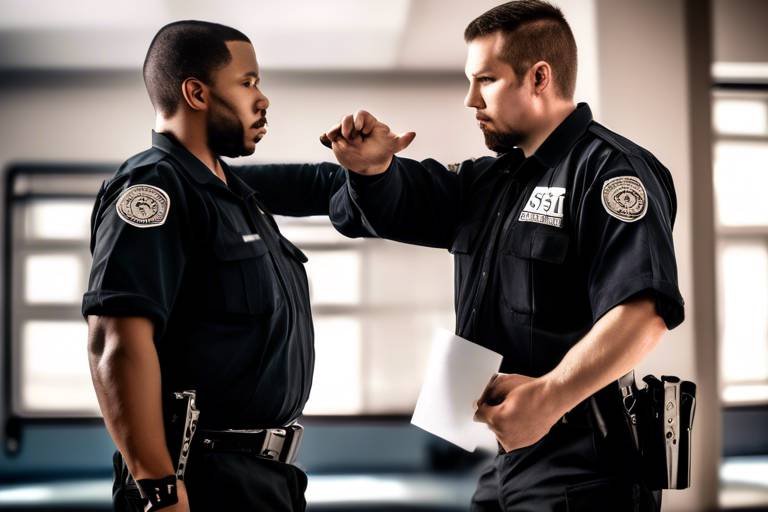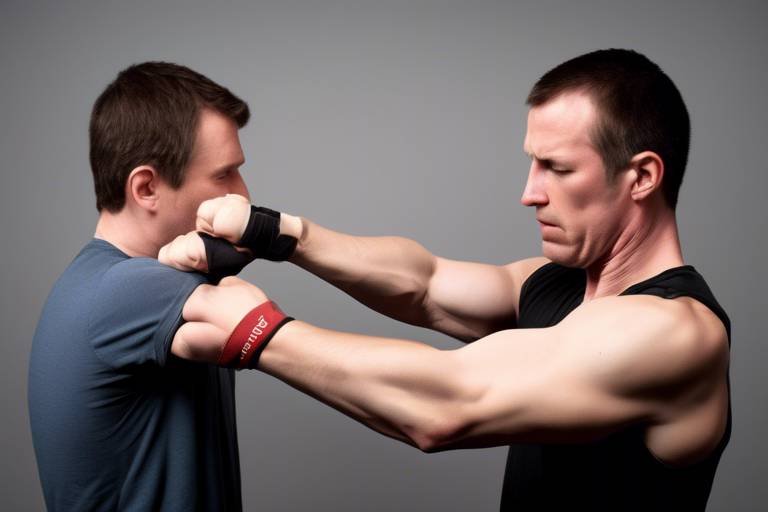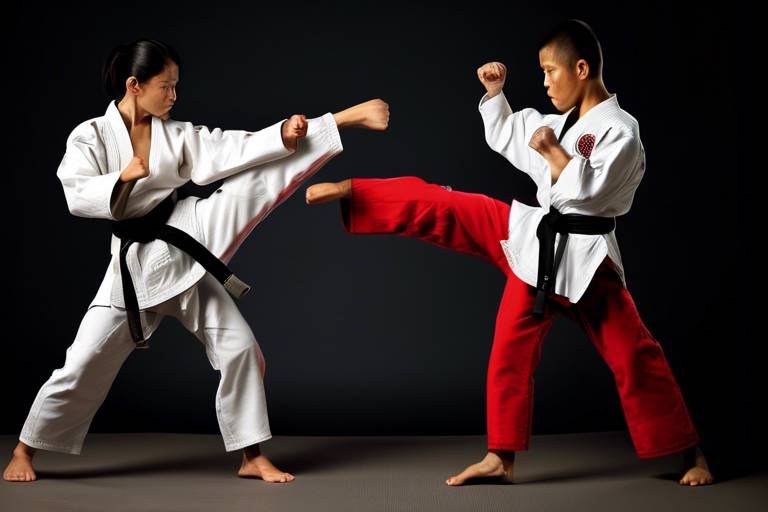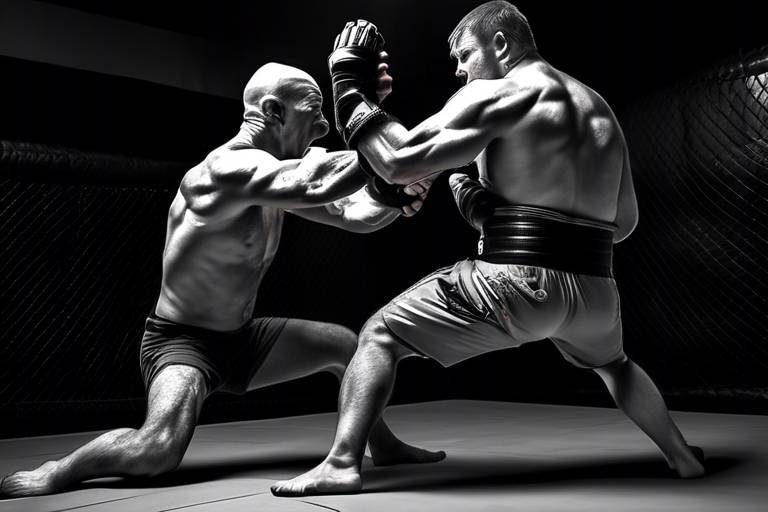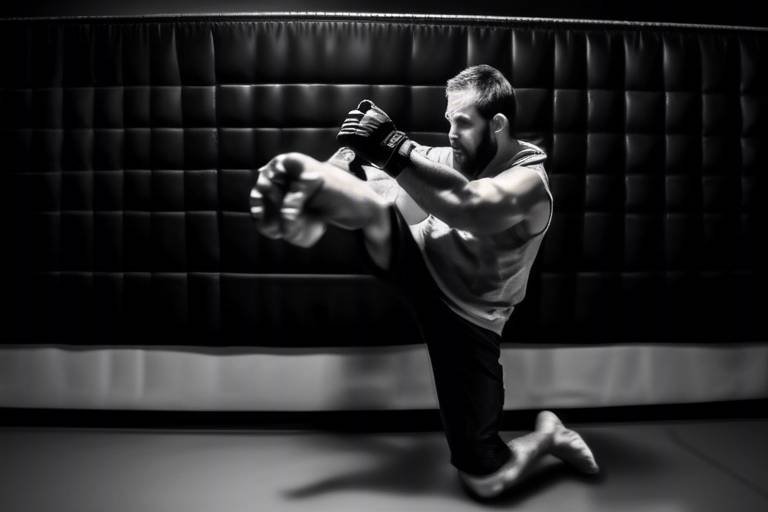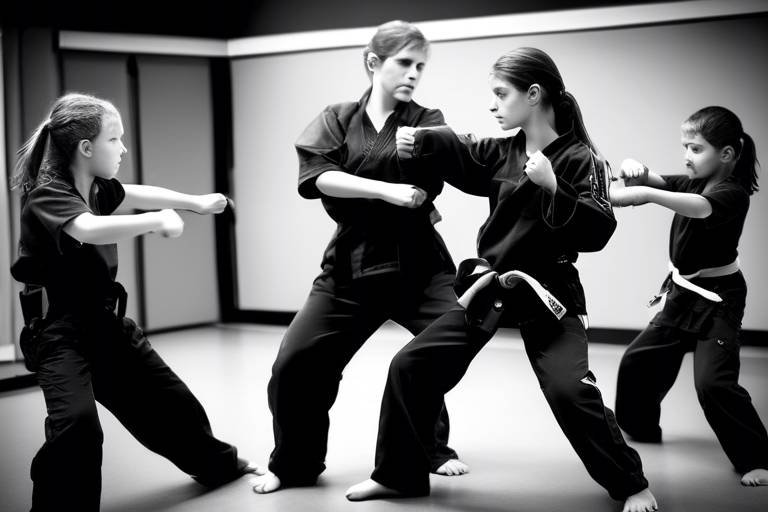Self-Defense Training for the Visually Impaired
In a world where personal safety is paramount, self-defense training serves as a beacon of empowerment, especially for individuals with visual impairments. Imagine walking down the street, feeling the warmth of the sun on your face, but also knowing that you have the skills to protect yourself if the unexpected happens. This article dives deep into effective self-defense techniques tailored for the visually impaired, focusing on strategies that enhance safety, boost confidence, and foster independence.
Self-defense training is not just about learning to throw a punch or execute a perfect kick; it’s about instilling a sense of security and self-assuredness. For visually impaired individuals, this training can be a transformative experience. It equips them with the essential skills needed to navigate potentially dangerous situations, thereby promoting personal safety and independence. Think of it as learning to ride a bike; at first, it may seem daunting, but once you find your balance, the freedom it brings is exhilarating!
Adaptive self-defense techniques are specifically designed to leverage the other senses—like hearing and touch. These methods enable visually impaired individuals to respond effectively to threats, enhancing their situational awareness and reaction time. For instance, the ability to listen carefully can help one detect a person approaching from behind, while touch can guide an individual in understanding their environment better. It's about turning perceived limitations into strengths. When you think about it, it's much like a musician who, despite being unable to see the notes, plays beautifully by feeling the rhythm and vibrations of the music.
One of the most powerful tools in self-defense is not physical at all—it's verbal. Verbal de-escalation techniques can prevent a confrontation from escalating into violence. Training individuals in effective communication skills empowers them to diffuse tense situations using assertive and calm dialogue. Imagine being able to talk your way out of a potentially dangerous encounter simply by maintaining composure and expressing yourself clearly. It's a skill that can be learned and mastered, providing a sense of control in unpredictable situations.
To truly grasp the essence of self-defense, engaging in role-playing scenarios can be invaluable. These practical exercises allow individuals to simulate real-life situations, helping them practice their responses to various threats. By stepping into different roles, participants gain confidence and prepare themselves for potential encounters. Picture this: you’re in a controlled environment, facing a situation that feels real, yet you know you have the support and guidance to navigate it successfully.
Developing listening skills is crucial for enhancing situational awareness. Training can focus on improving the ability to detect subtle changes in the environment, such as shifts in sound or movement. This heightened awareness can be the difference between safety and danger. Just like a seasoned detective who can pick up on the smallest clues, individuals can learn to tune into their surroundings, creating a mental map of potential threats.
While verbal skills are important, physical self-defense techniques also play a significant role. These techniques are adapted for those with visual impairments, focusing on body positioning, balance, and effective strikes. The goal is to enable individuals to defend themselves confidently and efficiently, even when they can't see their opponent. Imagine being a tree in a storm—rooted firmly and swaying just enough to withstand the pressure. These skills provide that same kind of stability and strength.
When it comes to self-defense, not all programs are created equal. Selecting a training program tailored to visually impaired individuals is crucial. Look for programs that prioritize safety, adaptability, and instructor experience. A program that understands the unique challenges faced by visually impaired participants will offer a supportive environment where learning can flourish. Think of it as finding the right pair of shoes; they should fit well and support you on your journey!
Qualified instructors with experience in teaching visually impaired students can provide tailored guidance. Their expertise ensures that training is accessible and effective, fostering a supportive learning environment. A good instructor is like a lighthouse—guiding individuals through the fog of uncertainty and helping them navigate their way to safety.
Accessibility in training programs is vital. Facilities should accommodate various needs, ensuring that all participants can engage fully in self-defense training without barriers. This means considering everything from physical space to instructional materials. An inclusive program is like a well-designed bridge, connecting individuals to their goals while ensuring everyone can cross safely.
Regular practice is essential for building confidence in self-defense skills. Consistent training sessions reinforce techniques and improve muscle memory, empowering individuals to respond effectively in real-life situations. Just like honing a craft, the more you practice, the more confident you become. Imagine being able to walk into any situation with the knowledge that you can handle it—what a liberating feeling!
- What should I look for in a self-defense program? Look for programs that are specifically designed for visually impaired individuals, focusing on safety, adaptability, and experienced instructors.
- Are verbal de-escalation skills really effective? Yes! They can often prevent physical confrontations and help individuals manage tense situations more effectively.
- How can I practice self-defense techniques at home? Many techniques can be practiced in a safe environment, like shadow boxing or role-playing scenarios with a friend.

Understanding the Importance of Self-Defense
Self-defense training is not just a luxury; it’s a necessity, especially for individuals with visual impairments. Imagine walking down the street, and suddenly, you feel a presence behind you. What do you do? This is where self-defense comes into play. It’s all about empowerment and confidence. When visually impaired individuals learn self-defense, they gain the skills to protect themselves in potentially dangerous situations. This training fosters a sense of independence, allowing them to navigate the world with greater assurance.
The importance of self-defense for the visually impaired can be broken down into a few key areas:
- Personal Safety: Knowing how to defend oneself can significantly reduce the risk of becoming a victim of crime.
- Boosting Confidence: Self-defense training instills a sense of confidence that can positively impact other areas of life.
- Independence: It promotes a greater sense of autonomy, enabling individuals to engage in daily activities without fear.
Moreover, self-defense training equips individuals with the mental tools necessary to assess situations critically. It’s not only about physical techniques; it’s also about understanding when to engage or disengage. For example, a well-timed verbal de-escalation can prevent a situation from escalating into violence. This knowledge can be incredibly empowering, as it allows individuals to feel in control of their environment.
In essence, self-defense training serves as a vital component of personal safety for visually impaired individuals. It’s not just about learning to throw punches or execute kicks; it’s about cultivating a mindset that values safety and preparedness. This preparation can make all the difference in a critical moment, transforming fear into action. So, why wait? Empower yourself or someone you know today through self-defense training!

Adaptive Techniques for Self-Defense
When it comes to self-defense, the notion of traditional techniques often conjures images of high kicks and complicated maneuvers. However, for individuals with visual impairments, self-defense is less about what one can see and more about leveraging other senses. Adaptive self-defense techniques focus on using hearing, touch, and intuition to navigate and respond to potential threats. This approach not only enhances situational awareness but also fosters a sense of empowerment and confidence in one’s ability to handle unexpected situations.
One of the key elements of adaptive self-defense is the utilization of verbal cues and body language. For instance, being able to recognize the tone of someone’s voice can provide critical insights into their intentions. A raised voice or aggressive tone may indicate a potential threat, allowing the individual to prepare mentally and physically for a response. Similarly, understanding the space around them through touch can help individuals gauge the distance between themselves and a potential aggressor, enabling them to react appropriately.
In addition to auditory and tactile awareness, role-playing scenarios are an invaluable part of adaptive training. These scenarios allow individuals to practice responses to various situations, from a simple confrontation to more aggressive encounters. By simulating real-life situations, participants can develop their instincts and refine their reactions, enhancing their confidence and readiness. For example, a trained instructor might simulate an approach from behind, allowing the student to practice their response without the fear of real harm.
Moreover, listening skills development plays a crucial role in situational awareness. Training can include exercises that focus on identifying subtle environmental changes, such as shifts in foot traffic, changes in voice volume, or even the sound of someone approaching. By honing these skills, individuals can better detect potential dangers before they escalate into confrontations. In essence, it's about creating a mental map of the environment using sound and touch, rather than relying solely on sight.
Physical techniques are also adapted for those with visual impairments, emphasizing body positioning and balance rather than visual cues. For instance, a strong stance can provide stability and control, allowing individuals to maintain their ground even in the face of aggression. Effective strikes, such as using the elbow or knee, can be taught in a way that doesn’t require visual confirmation, relying instead on muscle memory and spatial awareness.
Ultimately, the goal of adaptive self-defense training is to empower individuals to feel capable and in control of their safety. By focusing on these techniques, visually impaired individuals can develop a robust set of skills that not only enhance their personal security but also boost their overall confidence in navigating the world around them.

Verbal De-escalation Strategies
When it comes to self-defense, the power of words can be just as effective as physical techniques. are essential tools that can help individuals navigate potentially dangerous situations without resorting to violence. Imagine walking into a tense scenario where emotions are running high. Instead of jumping straight into confrontation, what if you could diffuse the situation simply by talking? This is where the art of verbal de-escalation comes into play. It’s about using your voice, tone, and choice of words to create a calmer environment.
One of the key aspects of verbal de-escalation is assertiveness. This doesn’t mean being aggressive; rather, it’s about expressing your thoughts and feelings clearly and confidently. For instance, if someone is approaching you aggressively, maintaining a calm demeanor and speaking in a steady voice can often help to lower the tension. You might say, “I don’t want any trouble. Can we talk about this?” This simple statement can shift the focus from confrontation to conversation.
Another important element is active listening. When you show that you are genuinely interested in what the other person is saying, it can help to ease their frustration. By nodding and responding appropriately, you can create a connection that may prevent the situation from escalating further. It’s like holding up a mirror to their emotions and reflecting back understanding. You might acknowledge their feelings by saying, “I can see that you’re upset. Let’s figure this out together.” This kind of empathy can work wonders in tense situations.
Additionally, it’s crucial to remain calm and composed. Your body language speaks volumes, and if you appear anxious or defensive, it may escalate the situation. Stand tall, keep your hands visible, and avoid crossing your arms, which can seem confrontational. Instead, use open gestures to show that you are approachable. Think of it as creating a safe space where dialogue can happen instead of conflict.
Incorporating these strategies into your self-defense training can make a significant difference. Here’s a quick summary of effective verbal de-escalation techniques:
- Stay Calm: Maintain a steady voice and composed body language.
- Be Assertive: Clearly express your feelings without being aggressive.
- Listen Actively: Show genuine interest in the other person's perspective.
- Acknowledge Feelings: Validate their emotions to create rapport.
By practicing these techniques, individuals can enhance their ability to manage conflict and protect themselves from potential harm. Remember, the goal is not just to avoid physical confrontation but to foster a sense of safety and control in any situation. With the right approach, you can turn a potentially dangerous encounter into a constructive conversation, empowering yourself and others in the process.

Role-Playing Scenarios
Role-playing scenarios are an incredibly effective way to prepare individuals with visual impairments for real-life confrontations. Imagine stepping into a safe space where you can practice responding to various threats without the fear of actual harm. This method not only enhances practical skills but also boosts confidence. When you engage in role-playing, you’re not just learning how to react; you’re experiencing the dynamics of a potential encounter in a controlled environment. This simulation is crucial because it allows participants to understand their instincts and refine their responses.
During these scenarios, participants can practice a range of responses, from verbal de-escalation techniques to physical defense maneuvers. For instance, a scenario might involve a simulated confrontation in a park where an individual approaches too closely. Here, the participant can practice using their voice to assert boundaries, while also learning to gauge the other person's intentions through tone and body language. The beauty of role-playing lies in its adaptability; scenarios can be tailored to the specific environments and situations that individuals may encounter in their daily lives.
Moreover, role-playing offers a unique opportunity for feedback. After each scenario, instructors can provide constructive criticism, highlighting what worked well and what could be improved. This feedback loop is vital as it encourages growth and development. Participants can also share their feelings about the experience, discussing what they found challenging or surprising. This open dialogue fosters a supportive atmosphere where everyone learns from one another.
To further enhance the learning experience, role-playing can incorporate different levels of intensity. For example, beginners might start with low-pressure situations, gradually moving to more complex scenarios as their skills improve. This progressive approach allows individuals to build their confidence incrementally. Additionally, incorporating unexpected elements—like an unexpected noise or a sudden change in the scenario—can train participants to remain calm and adapt to surprises, which is essential in real-world situations.
In conclusion, role-playing scenarios are not just a training tool; they are a gateway to empowerment. They allow visually impaired individuals to practice self-defense techniques in a safe environment, ultimately leading to greater confidence and preparedness. By simulating real-life situations, participants can learn to trust their instincts, refine their skills, and feel more secure in their ability to protect themselves.
- What is the purpose of role-playing in self-defense training? Role-playing helps individuals practice responses to potential threats in a safe environment, enhancing their confidence and situational awareness.
- How can role-playing scenarios be adapted for different skill levels? Scenarios can start with low-pressure situations for beginners and gradually increase in complexity as skills improve.
- What types of threats can be simulated in role-playing scenarios? Scenarios can include verbal confrontations, physical threats, and various environmental situations that individuals may encounter in daily life.
- How does feedback from instructors enhance the role-playing experience? Constructive feedback helps participants identify strengths and areas for improvement, fostering a supportive learning environment.

Listening Skills Development
Listening skills are not just about hearing; they are about tuning in to the world around you. For individuals with visual impairments, these skills become even more critical as they rely on sound to navigate their environment. Developing strong listening skills can significantly enhance situational awareness, allowing individuals to detect subtle changes that might indicate a potential threat. Imagine walking through a busy park; the sound of approaching footsteps, the rustle of leaves, or even the distant chatter of people can provide essential clues about what’s happening around you.
To cultivate these listening abilities, individuals can engage in various exercises that sharpen their auditory perception. For instance, practicing active listening in different environments can help. This could involve:
- Identifying Sounds: Try to identify different sounds in a busy area, such as the honking of cars, the laughter of children, or the chirping of birds. This practice can enhance your ability to discern important auditory cues.
- Sound Localization: Work on determining the direction of sounds. This can be done by closing your eyes and listening to sounds from various directions. This skill is crucial in situations where you need to react quickly.
- Listening to Conversations: Engage in listening exercises where you focus on understanding conversations happening around you. This can improve your ability to pick up on social cues and potential threats.
Additionally, incorporating technology can aid in developing listening skills. Many apps and devices are designed to enhance auditory perception and provide feedback on sound identification. These tools can make practice more engaging and effective, allowing individuals to track their progress over time.
Ultimately, the goal of enhancing listening skills is to empower individuals with the ability to respond confidently to their surroundings. By becoming more attuned to the sounds around them, individuals can better assess situations, make informed decisions, and react appropriately in potentially dangerous scenarios. Remember, the world is full of sounds that can guide you; it’s all about learning to listen.
Q1: How can I start developing my listening skills?
A1: Begin by practicing in different environments. Focus on identifying various sounds and their sources. You can also use apps designed for auditory training.
Q2: Are there specific exercises for improving situational awareness through listening?
A2: Yes! Engage in sound localization exercises where you try to pinpoint the direction of sounds, or practice active listening by focusing on conversations and identifying key points.
Q3: Can technology help in enhancing my listening skills?
A3: Absolutely! There are many apps and devices available that can help improve auditory perception and provide feedback, making your practice more effective and enjoyable.

Physical Techniques for Self-Defense
When it comes to self-defense, especially for those who are visually impaired, understanding physical techniques is essential. These techniques are not just about brute strength; they focus on body positioning, balance, and effective strikes that can help anyone defend themselves confidently and efficiently. The beauty of these techniques lies in their adaptability; they can be modified to suit individual needs and abilities. For instance, a simple yet effective move is learning how to maintain a strong stance. A solid stance not only provides stability but also enables you to react quickly when needed. Imagine standing like a tree, deeply rooted to the ground, ready to sway but not fall over. This foundational strength is crucial in any self-defense situation.
Moreover, understanding how to use your body weight can significantly enhance your defensive capabilities. By shifting your weight correctly, you can generate more power behind your strikes without needing excessive force. This principle is akin to using a lever; a little push can go a long way when applied effectively. For instance, if an assailant grabs your wrist, you can pivot your body and use your weight to break free, redirecting their energy against them. This technique not only empowers you but also illustrates the importance of using your environment to your advantage.
In addition to body mechanics, effective striking techniques must also be emphasized. Strikes can include punches, palm strikes, or even elbow strikes, which are particularly effective when someone is in close proximity. The key here is to aim for vulnerable areas of the body, such as the eyes, nose, or throat. By focusing on these targets, you can maximize the impact of your strikes, even if you don't possess immense physical strength. Think of it like a small but mighty storm; it doesn’t take a hurricane to cause damage, just a well-placed gust of wind.
Furthermore, practicing these physical techniques in a controlled environment, such as during training sessions, is crucial. Regular practice not only helps in mastering the moves but also builds muscle memory, allowing you to react instinctively in a high-pressure situation. It’s like learning to ride a bike; the more you practice, the more natural it becomes. Additionally, incorporating
- shadowboxing
- partner drills
- and controlled sparring
Finally, it’s important to remember that self-defense is not just about physical techniques; it’s about cultivating a mindset that prioritizes safety and awareness. By combining physical skills with mental preparedness, individuals can navigate potentially dangerous situations with confidence and poise. This holistic approach to self-defense not only empowers visually impaired individuals but also fosters a sense of independence and self-assurance that is invaluable in today’s world.
- What are the best self-defense techniques for visually impaired individuals?
Techniques that focus on body positioning, balance, and effective strikes are highly recommended. Additionally, verbal de-escalation and situational awareness are crucial. - How can I find a self-defense program tailored for visually impaired individuals?
Look for local community centers or organizations that specialize in adaptive training. Ensure the instructors are experienced in teaching individuals with visual impairments. - Is physical strength necessary for effective self-defense?
No, effective self-defense relies more on technique, strategy, and understanding body mechanics rather than sheer physical strength. - How often should I practice self-defense techniques?
Regular practice is essential. Aim for at least once a week to reinforce techniques and build muscle memory.

Choosing the Right Training Program
When it comes to selecting a self-defense training program for visually impaired individuals, making the right choice can feel overwhelming. With so many options available, how do you ensure that the program you choose truly meets your needs? The key is to prioritize aspects that will enhance your learning experience and empower you in real-life situations. Look for programs that are not only designed with your unique requirements in mind but also foster a supportive and encouraging environment. After all, self-defense is not just about learning techniques; it's about building confidence and developing the mindset to handle challenging situations.
One of the first things to consider is the qualifications of the instructors. Are they experienced in teaching self-defense to visually impaired individuals? Having instructors who understand the specific challenges faced by visually impaired students can make all the difference. They should be able to provide tailored guidance and adapt techniques to suit your abilities. A well-qualified instructor will not only teach you the physical skills needed for self-defense but will also instill a sense of safety and empowerment in their students.
Next, think about the accessibility of the program. This includes both the physical location and the resources provided. Ensure that the training facility is equipped to accommodate various needs, such as mobility aids or alternative instructional materials. A program that prioritizes accessibility will make it easier for you to engage fully without feeling limited or hindered by your surroundings. Additionally, consider the class sizes; smaller groups often allow for more personalized attention, which can enhance the learning experience.
Furthermore, it’s essential to evaluate the curriculum. Does it cover a range of self-defense techniques that are adaptable for visually impaired individuals? Look for programs that incorporate both verbal de-escalation strategies and physical techniques. A comprehensive curriculum will not only equip you with the skills to defend yourself but also teach you how to assess situations effectively and respond appropriately. Remember, self-defense is not just about fighting back; it’s also about recognizing potential threats and avoiding confrontation when possible.
Lastly, don’t hesitate to reach out to previous participants of the program. Their insights can provide invaluable information about the training experience. Ask about their progress, the effectiveness of the instruction, and how the program has impacted their confidence and safety awareness. Personal testimonials can help you gauge whether the program aligns with your goals and expectations.
In summary, choosing the right self-defense training program involves careful consideration of instructor qualifications, program accessibility, curriculum comprehensiveness, and feedback from past participants. By taking the time to evaluate these factors, you’ll be better equipped to select a program that not only teaches you essential self-defense skills but also empowers you to navigate the world with confidence.
- What should I look for in a self-defense instructor?
Look for instructors with experience teaching visually impaired individuals, as they will understand your unique needs and can provide tailored guidance. - Are self-defense classes safe for visually impaired individuals?
Yes, when taught by qualified instructors in accessible environments, self-defense classes can be safe and empowering. - How often should I practice self-defense techniques?
Regular practice is crucial; aim for consistent training sessions to reinforce skills and build muscle memory.

Instructor Qualifications
When it comes to self-defense training for the visually impaired, the experience and qualifications of the instructor play a pivotal role in the effectiveness of the program. A qualified instructor not only possesses a strong background in self-defense techniques but also understands the unique challenges faced by individuals with visual impairments. This dual expertise ensures that the training is both relevant and accessible, allowing participants to learn in a supportive environment.
First and foremost, instructors should have a recognized certification in self-defense. This certification demonstrates that they have undergone rigorous training and have a deep understanding of various self-defense strategies. However, certification alone isn't enough. Instructors must also have specialized training in teaching visually impaired individuals. This could include techniques for adapting physical movements, using verbal cues, and creating an inclusive atmosphere where everyone feels safe to practice.
Moreover, effective communication skills are essential for instructors. They should be able to convey complex concepts in a clear and concise manner, ensuring that all participants, regardless of their level of experience, can grasp the material. Empathy is another critical trait; instructors need to understand the fears and concerns of their students, creating a trusting relationship that encourages open dialogue and personal growth.
In addition to these qualifications, instructors should also have experience in real-world self-defense scenarios. This practical knowledge allows them to share valuable insights and techniques that go beyond textbook learning. For example, they can draw on their own experiences to illustrate how to remain calm under pressure or how to assess a situation quickly. This real-world perspective is invaluable, especially in a field where theory and practice must align.
Lastly, ongoing education is vital. The world of self-defense is constantly evolving, and instructors should stay updated on the latest techniques, tools, and trends. By participating in workshops and training sessions, instructors can refine their skills and bring fresh perspectives to their classes, ensuring that their students receive the best possible education.
In summary, when selecting a self-defense instructor for visually impaired individuals, consider the following key qualifications:
- Certification in self-defense
- Specialized training in teaching visually impaired students
- Strong communication and empathy skills
- Real-world self-defense experience
- Commitment to ongoing education and training
With the right instructor leading the way, visually impaired individuals can gain the confidence and skills they need to navigate the world safely and assertively.
Here are some common questions regarding self-defense training for visually impaired individuals:
- What should I look for in a self-defense program? Look for programs that prioritize safety, adaptability, and have instructors experienced in working with visually impaired students.
- Is physical strength necessary for self-defense? No, self-defense techniques can be adapted to leverage body positioning and balance rather than physical strength.
- How often should I practice self-defense techniques? Regular practice is essential; aim for at least once a week to reinforce skills and build confidence.
- Can self-defense training help with personal safety awareness? Absolutely! Training enhances situational awareness, helping individuals to identify and respond to potential threats more effectively.

Program Accessibility
When it comes to self-defense training for the visually impaired, is not just a nice-to-have; it's a fundamental requirement. Imagine walking into a training center that feels welcoming and inclusive, where every participant can engage without feeling out of place. This is the kind of environment that effective self-defense programs strive to create. Accessibility means more than just physical space; it encompasses everything from instructional methods to the resources available for participants.
First and foremost, the training facilities should be designed to accommodate individuals with various levels of visual impairment. This includes clear pathways, tactile markers, and appropriate lighting to assist those who may have partial sight. Additionally, instructors should be trained in adaptive teaching techniques that cater to different needs. For instance, they might use verbal cues or tactile demonstrations to ensure that all students grasp the concepts being taught.
Moreover, the curriculum should be flexible and adaptable. Not every visually impaired individual will have the same level of comfort or familiarity with physical self-defense techniques. Therefore, programs should offer a range of options, allowing participants to progress at their own pace. This could include:
- Individualized instruction tailored to specific needs.
- Group classes that foster a sense of community and support.
- Access to materials in various formats, such as braille or audio, to reinforce learning.
It's also essential for programs to provide opportunities for feedback from participants. This ensures that the training remains relevant and effective. By actively listening to the needs and experiences of visually impaired individuals, instructors can continually improve the accessibility of their programs.
In summary, accessibility in self-defense training programs is critical for fostering a sense of empowerment among visually impaired individuals. When they can fully engage in the learning process, they not only gain valuable skills but also build confidence and independence. Remember, the goal is to create an environment where everyone feels safe and capable of defending themselves, regardless of their visual abilities.
Here are some common questions regarding self-defense training for the visually impaired:
- What types of self-defense techniques are best for visually impaired individuals?
Techniques that rely on body positioning, balance, and awareness of surroundings are particularly effective. - How can I find a self-defense program that is accessible?
Look for programs that specifically mention their experience with visually impaired individuals and check reviews for accessibility features. - Are there any resources available for practice at home?
Many organizations provide audio guides and instructional videos tailored for visually impaired learners.

Building Confidence Through Practice
When it comes to self-defense, practice truly makes perfect. For individuals with visual impairments, building confidence in self-defense techniques is not just about learning moves; it's about reinforcing muscle memory and developing a sense of security in their ability to respond to threats. Regular practice sessions can significantly boost self-esteem and empower individuals to feel more in control of their personal safety. Imagine walking down the street, knowing that you have the skills to protect yourself if necessary. That sense of empowerment is invaluable.
One of the best ways to build confidence is through consistent training. Just like any other skill, the more you practice, the more comfortable you become. This can include everything from physical drills to situational role-playing. For instance, practicing specific self-defense moves in a controlled environment allows individuals to understand their body mechanics and how to effectively use their strength. Over time, these skills become second nature, making it easier to react instinctively in real-life situations.
Moreover, group training sessions can foster a sense of community and support. Engaging with others who share similar challenges can be incredibly motivating. Participants can encourage one another, share experiences, and practice techniques together, which not only enhances skill development but also builds friendships. This camaraderie can be a powerful source of confidence, as individuals realize they are not alone in their journey toward self-defense proficiency.
Additionally, instructors play a crucial role in this process. A good instructor will not only teach techniques but also provide constructive feedback. They can help identify areas for improvement and celebrate progress, no matter how small. This positive reinforcement is essential for building confidence. When students see their own growth, they are more likely to feel capable and ready to face potential threats.
Incorporating real-life scenarios into practice is another effective method for building confidence. Training that mimics actual situations can prepare individuals for the unexpected. For example, practicing how to respond to an aggressive approach or a sudden confrontation can help solidify learned techniques. By experiencing these scenarios in a safe environment, individuals can develop a mental toolkit for handling similar situations outside of training.
Lastly, it’s important to remember that self-defense is not just about physical techniques; it’s also about mental preparedness. Encouraging mindfulness and situational awareness can enhance an individual's ability to assess their surroundings and react appropriately. This mental aspect of self-defense training can be just as critical as the physical component, leading to a well-rounded approach to personal safety.
- How often should I practice self-defense techniques? Regular practice is recommended, ideally at least once a week, to reinforce skills and build confidence.
- Can self-defense training help with self-esteem? Yes, many individuals find that learning self-defense techniques boosts their self-esteem and empowers them in various aspects of life.
- Are there specific programs for visually impaired individuals? Absolutely! Many self-defense programs are tailored specifically for visually impaired individuals, focusing on adaptive techniques and safety strategies.
- What should I look for in a self-defense instructor? Look for instructors with experience in teaching visually impaired students, as they can provide specialized guidance and support.
Frequently Asked Questions
- What is self-defense training for visually impaired individuals?
Self-defense training for visually impaired individuals focuses on empowering them with techniques and strategies tailored to their unique needs. It emphasizes the use of other senses, such as hearing and touch, to enhance personal safety and confidence in potentially dangerous situations.
- Why is self-defense training important for the visually impaired?
Self-defense training is crucial for visually impaired individuals as it promotes personal safety, independence, and confidence. It equips them with the skills needed to protect themselves, fostering a sense of empowerment and reducing the fear of potential threats.
- What adaptive techniques are used in self-defense training?
Adaptive techniques in self-defense training include utilizing heightened listening skills, body positioning, and balance. These methods help visually impaired individuals respond effectively to threats, increasing their situational awareness and reaction time.
- How can verbal de-escalation strategies help?
Verbal de-escalation strategies are essential as they can prevent physical confrontations. By learning to communicate assertively yet calmly, individuals can diffuse tense situations, minimizing the need for physical self-defense.
- What role does practice play in building confidence?
Regular practice is vital for building confidence in self-defense skills. Consistent training sessions reinforce techniques and improve muscle memory, empowering individuals to respond effectively when faced with real-life threats.
- How do I choose the right self-defense training program?
When selecting a self-defense program, look for options that prioritize safety, adaptability, and instructor experience. Programs should be tailored to the needs of visually impaired individuals, ensuring effective learning in a supportive environment.
- What qualifications should instructors have?
Instructors should have experience in teaching visually impaired students and possess the necessary qualifications to provide tailored guidance. Their expertise ensures that training is accessible, effective, and fosters a supportive learning atmosphere.
- Are self-defense training facilities accessible?
Accessibility is crucial in self-defense training facilities. They should accommodate various needs, ensuring that all participants can engage fully in the training without barriers, thus promoting an inclusive environment.




